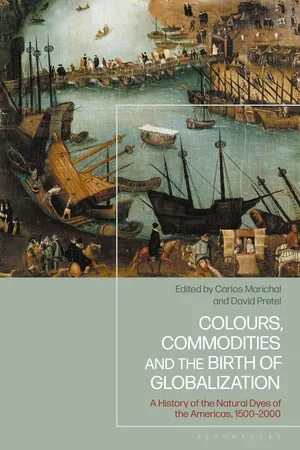
Colours, Commodities and the Birth of Globalization
A History of the Natural Dyes of the Americas, 1500-2000
- 256 pages
- English
- ePUB (mobile friendly)
- Only available on web
Colours, Commodities and the Birth of Globalization
A History of the Natural Dyes of the Americas, 1500-2000
About This Book
This volume explores the global history of natural dyes from the Americas and asks how their production and trade have shaped globalisation since early modern times. From their extraction and processing to their overseas trade, it shows how this commodity contributed to the rise of the textile industry and consumption in Europe, the United States and Latin America. In doing so, it sheds new light on the emergence of a global economy. Spanning several centuries, Colours, Commodities and the Birth of Globalization takes the reader from 1500 through the industrial revolutions of Europe and the United States and culminates in the synthetic age of the late-19th and early-20th centuries. Ranging from the indigo trade in the Atlantic to the secrets of the Indian production of cochineal, the chapters in this collection transcend nationally bounded historical narratives and explore transoceanic dynamics, imperial ambitions and the cross-cultural exchange of knowledge and techniques to better understand the birth of globalization.
Frequently asked questions
Information
Table of contents
- Cover
- Half-Title
- Title
- Contents
- List of Figures
- List of Tables
- List of Contributors
- 1 Introduction: The colours of globalization
- 2 The natural dyes of the Americas: Geography, labour and trade (sixteenth to nineteenth centuries)
- 3 The making of colonial blue: Mesoamerican indigo in the Iberian Atlantic, 1560–1620
- 4 A place under the sun: Brazilwood in the Brazilian economy (1500–1875)
- 5 Mexican cochineal and the material history of art (sixteenth to nineteenth centuries)
- 6 Logwood, masterless men and British interests in Yucatan and Central America
- 7 From abundance to scarcity: Dyewood production and trade in the Colombian Caribbean, 1700–1900
- 8 Indigo in eighteenth-century Venezuela: An unfinished history
- 9 Above and beyond Eliza Lucas Pinckney: Slave expertise and South Carolina indigo
- 10 Local production, Atlantic trade: The logwood economy in Laguna de Términos during the nineteenth century
- 11 Costa Rican neotropical dyewoods in global context, 1885–1940
- 12 Defying substitution: A Caribbean dyewood in the synthetic age
- 13 Epilogue
- Selected Bibliography
- Index
- Copyright